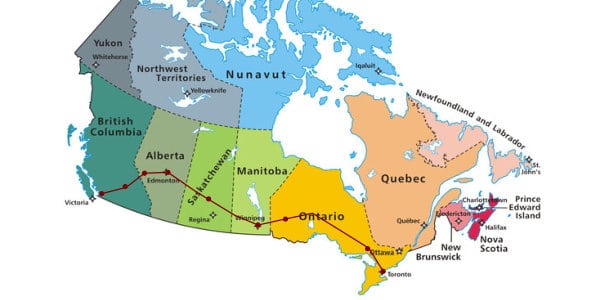VIA’s transcontinental passenger train, The Canadian, left Toronto two hours late, at midnight on May 26 last year, on the first leg of its 4,400-kilometre trip to Vancouver. Twelve hours later, it is stopped at Foleyet in northeastern Ontario for what seems like an eternity. The story goes that this little settlement was to be named for two locals, the Foley brothers, but no-one had got around to doing this. Questioned about the delay, an irate supporter of the brothers is said to have claimed, “We’re naming it for them, and it’ll be called Foley yet!”
The train’s unscheduled stops, usually in the middle of nowhere, are tiresome, but necessary: they are invariably to let freight trains pass. The longest so far was for a 140-car double-deck container freight train. Passenger trains must yield right-of-way on single-track stretches of the railway to freights bound for market, and the delays can, and do, play havoc with timetables. That first full day of this cross-Canada trip of ours had begun at daybreak with a view of forbiddingly rugged terrain passing our cabin window: rocks and trees, trees and more trees, for the most part silver birches; drowned forest with black stumps in sullen black water, sluggish creeks trickling through muskeg, past beaver lodges and waterlogged bogs, rocky outcrops of Canadian Shield, and the occasional majestic lake, with stately fir and spruce standing silent sentinel on the distant farther shore. At hardscrabble Capreol and similar small towns, the only industries seem to be wood processing and railway maintenance. A brief stop at Gogama (Ojibway for ’Jumping Fish’) reminds us of the nearby site of the recent winter derailment of a CN freight, with a consequent serious oil spill and fire. Aha! Time to go. My wife Louise and I smile at each other. With a sudden jerk and a clank, the train begins to move, and we are on the march again.
The next day we are still in Ontario. Leaving Longlac, a rough-and-ready logging town, we are treated to the sight of the placid ‘long lake’ itself, on a peninsula of which stands, in splendid isolation on the lake shore, a white clapboard church with a tall steeple beyond a long, curving road bridge over the train tracks. It is in stunning contrast to the unrelieved monotony of muskeg, trees and rocks beneath a steel-grey sky. Apparently there was a spectacular sunset last night, but after a superb dinner of prime rib au jus, served by courteous and efficient staff in the dining car, we had settled down to read in gently rocking comfort for the evening, and had missed it. Our cabin consists of two bunk beds that fold into the wall, a small spartan sink, a narrow doorway to a concealed toilet, and plenty of storage space. The VIA attendants, solicitous and hard-working, will transform the cabin daily from a bedroom into a sitting-room, but we decline the offer, preferring to keep the beds down so we can doze in comfort at intervals throughout the day.
Two consecutive tunnels bored through rock bring us seemingly suddenly from dense and gloomy rock-bound Ontario forest to a gentle landscape of lush farmland watered by the picturesque Whitemouth River near Elma, Manitoba. Soon we are in Winnipeg for a brief stop that permits us to see the confluence of the Red and Assiniboine rivers near the station, and cross over to St. Boniface to see Louis Riel’s grave, passing the new Museum for Human Rights on the way. On the train once more, it is soon time for an early lunch. We share a table with a retired Welsh teaching couple from Montreal. Another meal is spent in the company of the self-confessed “only Japanese pig farmer in southern Ontario” and his wife, both good-humoured and amusing. We also share meals with an English couple, an elderly lady travelling with her frail husband in declining health, and a lively young couple who work together as cabin crew on Air Canada flights. She is francophone, and talks animatedly to Louise en francais about the trip. We meet her again by chance while shopping in Vancouver two days later.
The forward sightline of the elevated rear-end dome car provides a view of the long train snaking ahead of us, curving to right and left with the track. We watch the panoramic vista of the passing scenery. We are on a long ridge above a fertile glacial valley through which the Assiniboine River winds. We pass potash facilities and round pools inexplicably set in the middle of fields. From beneath the dome we have a panoramic view of the countryside, soft and rolling beneath an infinite blue sky. As this gives way to flat prairie, I reflect that westbound pioneers more than a century ago must have felt that, after Ontario, they had entered the Promised Land. We make small talk with Ted, a retired teacher, and Nancy his wife, a nurse, from Belleville, between taking innumerable snapshots of the passing landscape, a habit that becomes a compulsion, a futile effort to capture the beauty of the view from the dome, an impulse doomed to disappointment as so few of us possess either the expertise or professional equipment to do it justice.
In the late afternoon and early evening we amble across Saskatchewan prairie all now sown for summer, waiting for the wheat to sprout. It is by no means dull, as some have claimed. On the contrary, it is a welcoming, human landscape, dotted, for all its vastness, with little towns beside the tracks on both sides. Neat, small houses, angle parking for a few isolated cars on the deserted main street perpendicular to the tracks, the highway running parallel to them to the next identical small town marked invariably by towering concrete grain elevators, the wooden ones beside them sadly disused and crumbling, like the barns of abandoned Eastern Ontario farmsteads. Watrous is one such small town: near it is Little Manitou Lake, said to be more saline than the Dead Sea. Numerous pools dot the prairie; some are big enough to qualify as boating lakes. These are apparently quite shallow, and, we are told, will dry up as summer heat settles in. We meet two people from Ottawa under the dome once more, a man of Polish extraction very proud of his father’s role as a pilot in the RAF during the Battle of Britain after Poland fell to the Nazis, and a retired army officer who had been educated at Toronto’s exclusive Upper Canada College.





